Sun Dial Solar Office Building
|
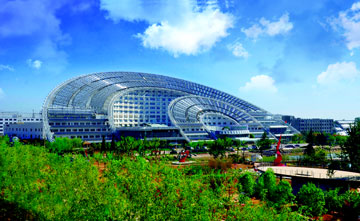
|
| Solar energy is the focal point of this project. Passive use of solar energy light and warmth is used ever since we, humans, are aware of ourselves. |
World’s Largest Solar Powered Office Building, Dezhou, China
It is a paradoxical scenario in China. If pollution is one aspect of the broader topic of environmental issues in China on one front that is causing environmental and health problems, while it is taking several key steps to protect its environment on the other side too. Slowly and steadily they are choosing wind and solar power as their source of energy. China has earned the distinction of having the world’s largest solar-powered building. It is situated in Dezhou, Shangdong Province in northwest China. The building covers an area of 75,000-square-meter. The office building is modelled after the ‘sun dial’ structure and hence called Sun Dail Solar Powered Office Building.
A lack of fossil fuel burning indeed makes the building decidedly green, but its architecture hides several other energy- and resource-saving innovations like advanced wall insulation and roofing that help trim 30% its energy consumption compared to the national average. And while massive, the external structure actually uses 1% of the steel that the People's Republic poured into the Bird's Nest for the 2008 Summer Olympic Games.
The building provides many services such as space for exhibition centers, scientific research facilities, meeting and training facilities and a sustainable hotel. This building is named as the Sun and the Moon Altar micro-row buildings. The architecture included the Chinese characters for sun and moon. The solar building has a white exterior that represents clean energy.
The building will procure 95% of its energy needs from alternative energy sources. They have installed a 5000 square meter solar panel array on the building complex. This building also has the facilities of solar hot water, a solar desalination plant and a solar energy theme park.
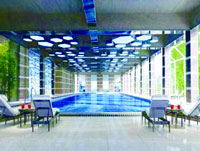 |
The clean and green ideas are not confined to the massive solar array only but can be spotted in the whole building complex. The building’s pioneering solar energy and power-saving technologies, a few already patented, include a number of technical advancements that will push forward the mass application of solar energy. |
The exterior of the building is dressed fully in solar panels, and its interior houses offices, scientific research facilities, exhibition centres, meeting halls and conference rooms, training facilities and even a hotel. All of these facilities run completely on solar power.
Solar Architecture
Solar energy is the focal point of this project. Passive use of solar energy light and warmth is used ever since we, humans, are aware of ourselves. The first steps to use the Sun for producing something was to concentrate the Sun’s rays to gain fire and use this fire in different religious and household needs – 7th Century BC. During time, when more complicated buildings with glass windows developed, the function of the glazed surface was not only giving a possibility to look through the building envelope but also gain warmth from the Sun, by situating these surfaces to the side where the Sun shines at most. The passive use of sunlight was intentional and used in more and more ways, and these methods are used also nowadays in solar architecture.
Solar architecture is the integration of passive solar or solar panel technology with modern building techniques. The use of flexible thin-film photovoltaic modules provides fluid integration with steel roofing profiles, enhancing the building's design. Orienting a building to the sun, selecting materials with favorable thermal mass or light dispersing properties, and designing spaces that naturally circulate air also constitute solar architecture.
Initial development of solar architecture has been limited by the rigidity and weight of standard solar power panels. The continued development of photovoltaic (PV) thin film solar has provided a lightweight yet robust vehicle to harness solar energy to reduce a building's impact on the environment.
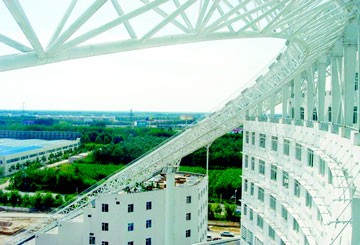 |
The sun dial shape is symbolic of the fact that the sun is one of the most important renewable energy sources, as the world looks for fossil fuel substitutes. The exterior of the building is dressed fully in solar panels, and its interior houses offices, scientific research facilities, exhibition centres, meeting halls and conference rooms, training facilities and even a hotel. All of these facilities run completely on solar power. The green and clean initiatives of this building don’t end with the use of solar power, however. It also features state-of-the-art materials and construction methods for roof and wall insulation, and this allows it to save 30% more energy than the recommended national standard. Besides, the architecture of the building is a lesson in economy.
Sun Dial-Integral Part of Solar Valley
The local government of a city can actively support the establishment of local renewable energy (RE) industries, such as the creation of clusters for private actors, public stakeholders and research institutions. Such synergies can also stimulate innovation and economic development. A recent successful example of this can be found in the City of Dezhou in China. In 1997, the municipality and local government of Dezhou elaborated a Development Plan for the Dezhou Economic Development Zone to centralise solar technology research and development, manufacturing, education and capacity building. The local government of Dezhou would attract direct investments by implementing supportive policies on land-usage, tax-return and financing to overcome the relatively small size of the local solar energy industry, the lack of well-developed financing mechanisms for growing industrial companies and the shortage of sector related skills and expertise. Dezhou now boasts over 120 solar energy enterprises which generate an annual turnover of USD 3.46 billion. It has established a mature technology innovation system, as well as excellent capacities in engineering, research and commercialisation.
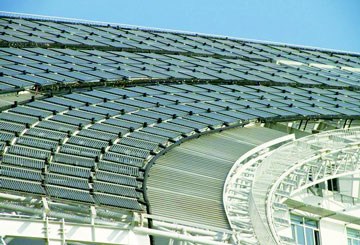 |
It is interesting to note that the Sun Dial building is not China’s or even Dezhou’s final word in solar initiative. The building is just the highlight feature of an entire solar-powered technology complex that is still under construction. The complex, known simply as ‘Solar Valley’ has been envisioned by a group known as Himin Solar Energy, which has its headquarters on-site, in the Sun-Moon Mansion. The total cost of the project is $740 million, and Himin Solar Energy has proudly announced that this will be the ‘Biggest Solar Energy Production Base in the Whole World’.
China hopes that this tech hub will become the centre of research into clean energy uses, and will eventually achieve the stature of California’s famous Silicon Valley. The prospects certainly look bright. Furthermore, nearly 100 companies have already booked their space in the valley, and work is underway in establishing a research centre and several factories. It is only fitting that Dezhou is the venue of Solar Valley, considering that the city has already shown an unusual level of initiative in clean energy use. There is already a rule in place that all new buildings being constructed must be equipped with solar water heaters, and only last year the city spent $10 million on the installation of solar streetlights along several miles of road.
Huang Ming, the ‘Sun King’ of China
Construction is in the works for what China is calling “The Biggest Solar Energy Production Base in the Whole World,” or more simply, Solar Valley. The base will be a clean energy technology hub that China hopes will rival Silicon Valley in California. The ambitious plans for the park were launched by Himin Solar Energy, whose headquarters is located at the Sun-Moon Mansion, which is currently the largest solar powered office building in the world. The planned development outside of Dezhou, China is expected to cost $740 million and accommodate 100 tenants.
Himin Solar Energy, started by Huang Ming, the ‘Sun King’ of China, is already the main tenant of Solar Valley and their large office building is completely powered by the sun. He has very ambitious goals about making Solar Valley a reality, and has already attracted about 100 companies, and spawned factories as well as a research centre. The hope is that this clean energy epicentre will help propel China’s development of renewable energy technology and installation.
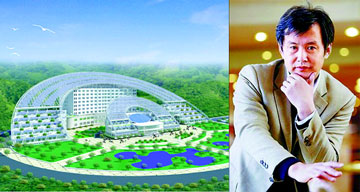 |
Huang Ming recently proposed using solar thermal energy to satisfy thermal needs in industry, agriculture and daily life in a large scale. He has worked wholeheartedly to promote the substitution of thermal energy with conventional energy, and this strategy had been listed in the development of China’s state renewable energy resources plan. He has also created the first timetable for energy substitution on behalf of all people. As he envisions it, there will be several phases, the first one is the “Recent Substitution Timetable”: by 2020, renewable energy will substitute 25% of conventional energy, including 12% solar energy. Then the “Metaphase Substitution”: by 2040, renewable energy will substitute 55% of conventional energy, including 25% solar energy. Finally, “Future Substitution”: by 2060, renewable energy will substitute 90% of conventional energy, including 50% solar energy.
Dezhou city already requires that all new buildings be equipped with solar water heaters of the type made by Huang’s company, and last year they spent $10 million to install solar lighting along miles of road. Chiel Boonstra, a Dutch architect who heads up the International Solar Cities Congress, says that Dezhou “will be a new centre of gravity for renewable technologies.” It’s just a shame that rural farmers are being relocated into block apartments in the city to make way for the grand new development.
Dezhou can safely be termed as a solar city because among 5.5 million people living in this city most of them opted for the solar hot water systems. In this city, solar energy is all pervasive. It powers everything from street lighting to tourist cars.
Greenpeace, an independent global campaigning organisation that acts to change attitudes and behaviour, to protect and conserve the environment put forth some statistics for this city. According to them, in 2007, 800,000 people in Dezhou had jobs in the solar panel industry.
Interesting Features
The building covers an area of 75,000-square-meter
The total cost of the project is $740 million
Dezhou now boasts over 120 solar energy enterprises which generate an annual turnover of USD 3.46 billion
The building will procure 95% of its energy needs from alternative energy sources
Nearly 100 companies have already booked their space in the valley
References:
http://www.popsci.com/science/article/2009-12/chinese-sun-dial-worlds-largest-solar-powered-office-building
http://www.alternative-energy-news.info/china-largest-solar-office-building/
http://urban-review.com/dezhou-solar-valley-china%E2%80%99s/
http://www.worldrecordacademy.com/biggest/largest_solar_energy_building_Chinese_Sun_Dial_sets_world_record_101497.htm
http://www.archi-europe.com/news-910-china-building-biggest-solar-energy-production-bas.html
http://www.excellerated.com/huang-ming
https://www.irena.org/Publications/RE_Policy_Cities_CaseStudies/IRENA%20cities%20case%201%20Dezhou.pdf